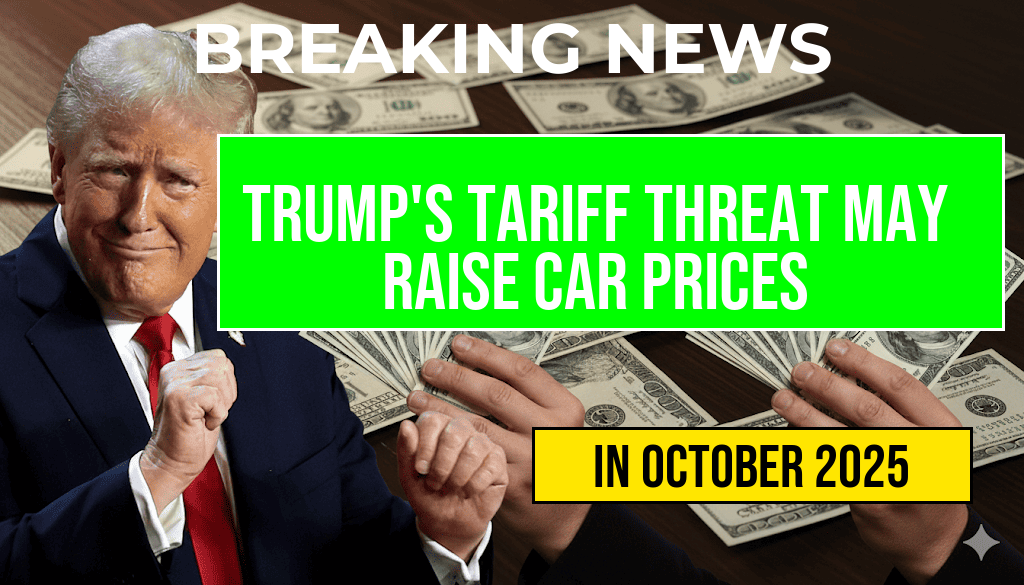Recent developments suggest that former President Donald Trump’s proposed tariff threats could significantly impact the automobile industry, potentially raising the average price of new vehicles by as much as $5,286. Experts warn that such measures could ripple through the supply chain, increasing costs for automakers and consumers alike. The threat comes amid ongoing trade negotiations and policy debates over tariffs on imported goods, with the automotive sector particularly vulnerable due to its heavy reliance on international parts and manufacturing processes. If enacted, these tariffs could alter the landscape of vehicle pricing, complicate supply chains, and influence consumer purchasing decisions at a critical juncture for the industry.
Understanding the Proposed Tariffs and Their Potential Impact
Background on Tariff Threats
During his tenure, Donald Trump frequently utilized tariffs as a strategic tool in trade negotiations, especially targeting China and other major trading partners. The latest threat involves potential tariffs on imported automobiles and automotive parts, which could be reintroduced or intensified depending on ongoing negotiations. These measures aim to protect domestic manufacturing but risk escalating costs across the supply chain.
How Tariffs Influence Vehicle Pricing
Tariffs increase the cost of imported goods by imposing additional taxes at customs. For automakers, this can translate into higher prices for vehicles that rely on foreign-made components, such as engines, electronics, and body parts. Manufacturers may pass these costs onto consumers, leading to a potential price hike of up to $5,286 per vehicle, according to industry analysts. This estimate draws from models that account for current vehicle prices, import dependencies, and tariff rates, highlighting the financial strain that tariffs could impose on consumers.
Industry Response and Consumer Implications
Automaker Strategies and Market Effects
- Price Adjustments: Automakers may need to increase vehicle prices to offset higher import costs, potentially reducing affordability for average buyers.
- Supply Chain Reconfiguration: Companies might seek alternative suppliers or shift production closer to home to mitigate tariff impacts, which could lead to increased manufacturing costs and delays.
- Shift in Consumer Behavior: Elevated vehicle prices could dampen demand, prompting consumers to consider used vehicles or delay purchasing altogether.
Potential Market Shifts
Higher vehicle prices could influence the broader automotive market, possibly accelerating the adoption of electric vehicles (EVs) and domestically produced models. However, increased costs might also dampen overall industry growth, especially if consumers opt for used cars or defer new purchases, affecting automakers’ sales and profitability.
Economic and Political Considerations
Trade Policy and Industry Stability
The prospect of tariffs rekindles debates over trade policy’s role in supporting American manufacturing versus the risk of inflationary pressures on consumers. Policymakers face a balancing act between protecting domestic jobs and maintaining competitive vehicle prices. The automotive sector, which contributes significantly to employment and economic output, remains at the center of these discussions.
Historical Context and Future Outlook
Historically, tariffs have led to short-term price increases but also prompted shifts in manufacturing strategies and international trade relations. The current situation echoes past episodes where tariff threats prompted industry adjustments, though the scale of potential price hikes remains unprecedented. Analysts monitor political developments closely, as any policy shifts could rapidly alter the market landscape.
Data on Vehicle Price Increases Due to Tariffs
| Vehicle Type | Current Average Price | Potential Price Increase | Total Estimated Price with Tariffs |
|---|---|---|---|
| Sedan | $25,000 | $2,500 | $27,500 |
| SUV | $35,000 | $3,786 | $38,786 |
| Pickup Truck | $40,000 | $4,286 | $44,286 |
Industry Experts Weigh In
Automotive analysts warn that even the threat of tariffs can cause market uncertainty, affecting pricing strategies well before any official implementation. Trade tariffs have historically influenced consumer confidence and industry investments, making the current situation a critical point for stakeholders.
Potential Consumer Outcomes
- Increased vehicle prices may lead to decreased new car sales.
- Consumers might turn to used vehicles or extended lease options.
- Long-term price hikes could slow industry growth and innovation investments.
As policymakers deliberate, consumers and industry players remain watchful. The outcome could reshape the pricing landscape, with ripple effects felt across the economy. For more insights into trade policies and their economic implications, visit Forbes or Wikipedia’s page on the U.S. automotive industry.
Frequently Asked Questions
What is the main concern regarding Trump’s tariff threat on new cars?
The primary concern is that Trump’s tariff threat could lead to an increase in vehicle prices by up to $5,286, making new cars more expensive for consumers.
How might tariffs impact the overall cost of purchasing a new vehicle?
Tariffs on imported vehicles and auto parts can raise manufacturing costs, which are often passed on to buyers, resulting in higher vehicle prices.
Which vehicles are most likely to be affected by these tariffs?
Imported cars from countries like Canada and Mexico are most vulnerable to tariff impacts, especially if tariffs are applied broadly to auto imports.
Could this tariff threat influence the auto market and consumer choices?
Yes, increased vehicle prices could decrease demand for new cars, potentially shifting consumer preferences toward used cars or delaying new purchases.
Is there any way for consumers to mitigate the potential price increases?
Consumers might consider buying early before tariffs take full effect, exploring alternative models, or looking into domestically produced vehicles to avoid higher costs.

Leave a Reply